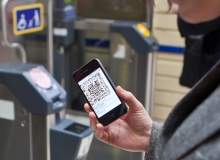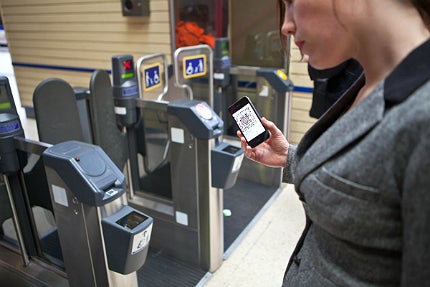

Masabi’s cloud-based JustRide product is driven by Amazon Web Services (AWS). It provides an end-to-end mobile ticketing and fare collection system to more than half the rail companies in the UK, and in Boston (the US’s first system-wide deployment of mobile ticketing) and San Diego. It has also partnered with New York’s MTA on a smartphone ticketing pilot scheme.
As smartphone usage has increased, Masabi’s fast and secure system has seen phenomenal success in the last thirteen years and ticket sales using its mobile technology have now passed US$100m.
Migrating from traditional server hosing to AWS’s cloud-based services has enabled the company to offer more reliability, flexibility and scalability than ever before
Frances Marcellin: How does Amazon Web Services support the service that Masabi provides transit operators?
Ben Whitaker: We provide a mobile application that includes timetables, the processing of credit card payments and customers’ personal details, the storage of those payment details and customer service and refunding interfaces.
Masabi provides this backend service as a full turnkey service to our transit clients, and all of that is now hosted on Amazon Web Services.
FM: How did you manage your server systems before?
BW: Previously Masabi used traditional, physical hosting with a professional hosting supplier who would use their hosting centre to install the computers.
We would advise, for example, where the firewalls and databases go, where to put the backups and what versions of the operating systems to run. Then Masabi would log into those machines, set them up and configure and run them.
Whenever we wanted to expand our capacity we’d have to pay them to buy new equipment, wheel it into our private area, install it, commission it and so on, and that process could take weeks.
It would also mean we would pre-commit to use that server – and pay for maintenance – for somewhere between one and five years.
FM: How has this enhanced Masabi’s operations and the service you can provide?
BW: With AMS we’re able to set up an account and, purely through its online configuration interface, create a private area and immediately start creating new machines, with firewalls and databases and so on.
We can structure it how we want, set up the backups and log in immediately to complete installation and configuration. Now, instead of having to wait for weeks to commission something, we can do it the same day.
FM: How does it help you to be more flexible in your daily operations?
BW: Should any of the underlying hardware break down or need something replacing, they simply load our virtual machine onto a different piece of hardware and change our physical piece under the hood.
And if we suddenly get three times as many customers to support, we simply log into the AWS private cloud and add new computers, simply by creating a clone. In a matter of minutes we can have new machines and triple our capacity.
FM: How much does this kind of flexibility cost?
BW: We only pay Amazon for the time that we use. So, instead of us having to spend on mainframes and huge numbers of computers, just for those few times we have terrible weather and everybody wants to look up train times simultaneously, we only pay when the demand is there.
After that we can go back to regular service. Not only does it mean we can create and modify our systems more quickly, the real amazing thing is that we can scale up and down quickly – it’s just a breath of fresh air.
FM: What has this meant for your uptime?
BW: Ever since we’ve moved from traditional hosting – which we’ve done for years – to cloud, not only is everything easier to run, but we’re 99.999% available.
The cloud is really setting new expectations in the industry in terms of what can be done with these IT systems.
The moment you give someone an app there is no maintenance window.
There is literally not a minute in the week that someone isn’t trying to buy tickets on our servers.
FM: How do you manage to upgrade systems without downtime for maintenance?
BW: Now we can clone the machines we can run "rolling upgrades" on those clones and, when they’ve passed the test, put those into service.
That way we’re able to have 100% of full rush hour capacity at the same time as doing upgrades and testing.
FM: In terms of payments and passenger data, how secure is Masabi’s system?
BW: We’ve basically built the entire system to be PCI DSS Level 2 compliant – and we recently took the entire Amazon system and our systems through a full audit and passed with flying colours.
This system stores and processes credit cards, and does all of that in a virtual private cloud, which is behind its own internal firewall.
FM: How is AMS transforming your business?
BW: We’re able to have more confidence than ever before in spikes and changes in demand, and we are also adding new data visualisation tools that grab all the data and make it easier to understand.
The transit companies have a lot of data, but they can’t necessarily get a lot of intelligence from it.
Now we’re able to run our real-time data visualisation data tools throughout the day and see what is going on in real time.
FM: How much quicker is it to set up this kind of service now than before?
BW: It actually took us three minutes. Before it would have taken the best part of a week to do. This has allowed us to be more responsive and has transformed the way we run live services.
FM: Does Masabi’s technology help transit companies to demand forecast?
BW: Very much so. A lot of the transit companies who we worked with previously only had occasional clip board work and the only other data they had was bulk ticket sale information at the end of any given sales period.
Now everyone is travelling on mobile tickets, they can see a real-time curve of information, such as where people are travelling to and from, and the pressure on the station at any time of day.
It is becoming incredibly accurate, as they have a running sample across their entire network for everyone who is using mobile.
FM: How does the system improve passenger flow?
BW: Passengers have a journey manager that tracks and supports them throughout their entire journey. This means that they don’t have to stand and wait for board information, the app will know it before it is displayed so they can go directly to the platform.
All information is provided through digital ticketing via the Amazon cloud – and we can supply every single passenger with that personal information on a continuous basis.
FM: Masabi has seen enormous growth in the last twelve months, is this reflected in its ticket sales?
BW: The past twelve months have seen huge and consistent growth, to the point we are now processing mobile ticketing sales of $85m per year.
This is a massive milestone, not just for Masabi but for the whole industry, to recognise the consumer demand for mobile as a core ticket sales channel.
Related content
NextAgent: the next step in transport ticketing?
Cubic Transportation wants to change the ticketing game with NextAgent, its futuristic virtual ticketing concept.
How biometrics are transforming onsite time and attendance tracking
Railway construction projects have always been under considerable pressure to finish on schedule and one area that poses a particular challenge is onsite time and attendance reporting.



